Schmitt C.B. (ed.) The Cambridge History of Renaissance Philosophy
Подождите немного. Документ загружается.

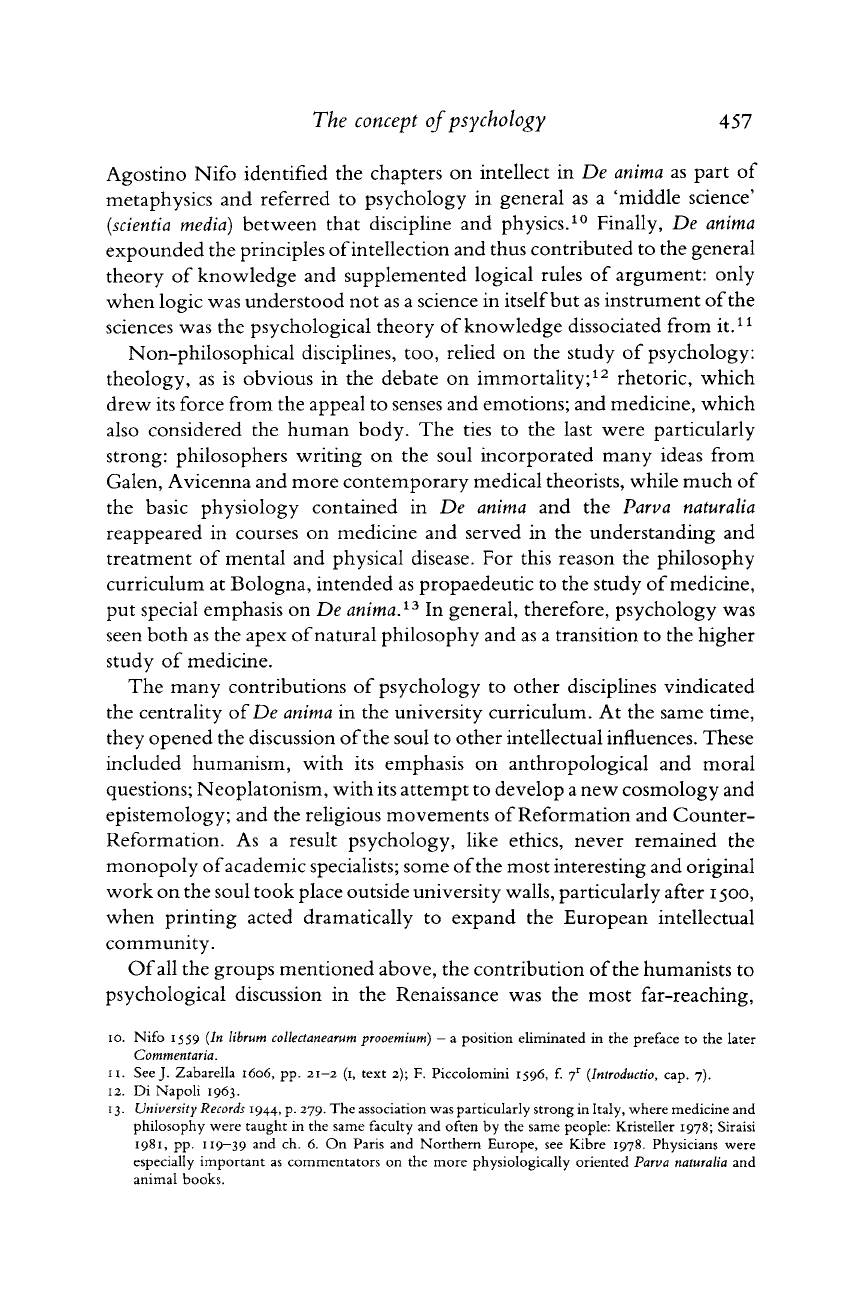
The
concept
of
psychology
457
Agostino
Nifo
identified the chapters on intellect in De
anima
as
part
of
metaphysics and referred to psychology in general as a 'middle science'
(scientia
media)
between that discipline and physics.
10
Finally, De
anima
expounded the principles
of
intellection and thus contributed to the general
theory
of knowledge and supplemented logical rules of
argument:
only
when logic was understood not as a science in itself but as instrument
of
the
sciences was the psychological theory of knowledge dissociated from it.
11
Non-philosophical disciplines, too, relied on the study of psychology:
theology, as is obvious in the debate on immortality;
12
rhetoric,
which
drew
its force from the appeal to senses and emotions; and medicine, which
also considered the human body. The ties to the last were particularly
strong:
philosophers writing on the soul incorporated many ideas from
Galen, Avicenna and more
contemporary
medical theorists,
while
much of
the
basic physiology contained in De
anima
and the
Parva
naturalia
reappeared
in courses on medicine and served in the understanding and
treatment
of mental and physical disease. For this reason the philosophy
curriculum
at Bologna, intended as propaedeutic to the study of medicine,
put special emphasis on De
anima.
13
In general, therefore, psychology was
seen both as the apex
of
natural
philosophy and as a transition to the higher
study of medicine.
The
many contributions of psychology to other disciplines vindicated
the
centrality of De
anima
in the university curriculum. At the same time,
they opened the discussion
of
the
soul to other intellectual influences. These
included humanism, with its emphasis on anthropological and moral
questions; Neoplatonism, with its attempt to develop
a
new cosmology and
epistemology; and the religious movements of
Reformation
and Counter-
Reformation.
As a result psychology, like ethics, never remained the
monopoly
of
academic
specialists; some
of
the
most interesting and original
work
on the soul took place outside university walls,
particularly
after
1500,
when printing acted dramatically to expand the European intellectual
community.
Of
all the groups mentioned above, the contribution
of
the
humanists to
psychological discussion in the Renaissance was the most far-reaching,
10.
Nifo
1559 (In librum collectanearum prooemium) - a
position
eliminated
in the
preface
to the
later
Commentaria.
11.
See J. Zabarella 1606, pp. 21-2 (1,
text
2); F.
Piccolomini
1596, f. 7
r
(Introductio, cap. 7).
12.
Di Napoli 1963.
13.
University Records 1944, p. 279. The
association
was particularly
strong
in Italy,
where
medicine
and
philosophy
were
taught in the
same
faculty and
often
by the
same
people:
Kristeller
1978;
Siraisi
1981,
pp. 119-39
an
d ch. 6. On
Paris
and
Northern
Europe, see Kibre 1978.
Physicians
were
especially
important
as
commentators
on the
more
physiologically
oriented
Parva naturalia and
animal
books.
Cambridge Histories Online © Cambridge University Press, 2008
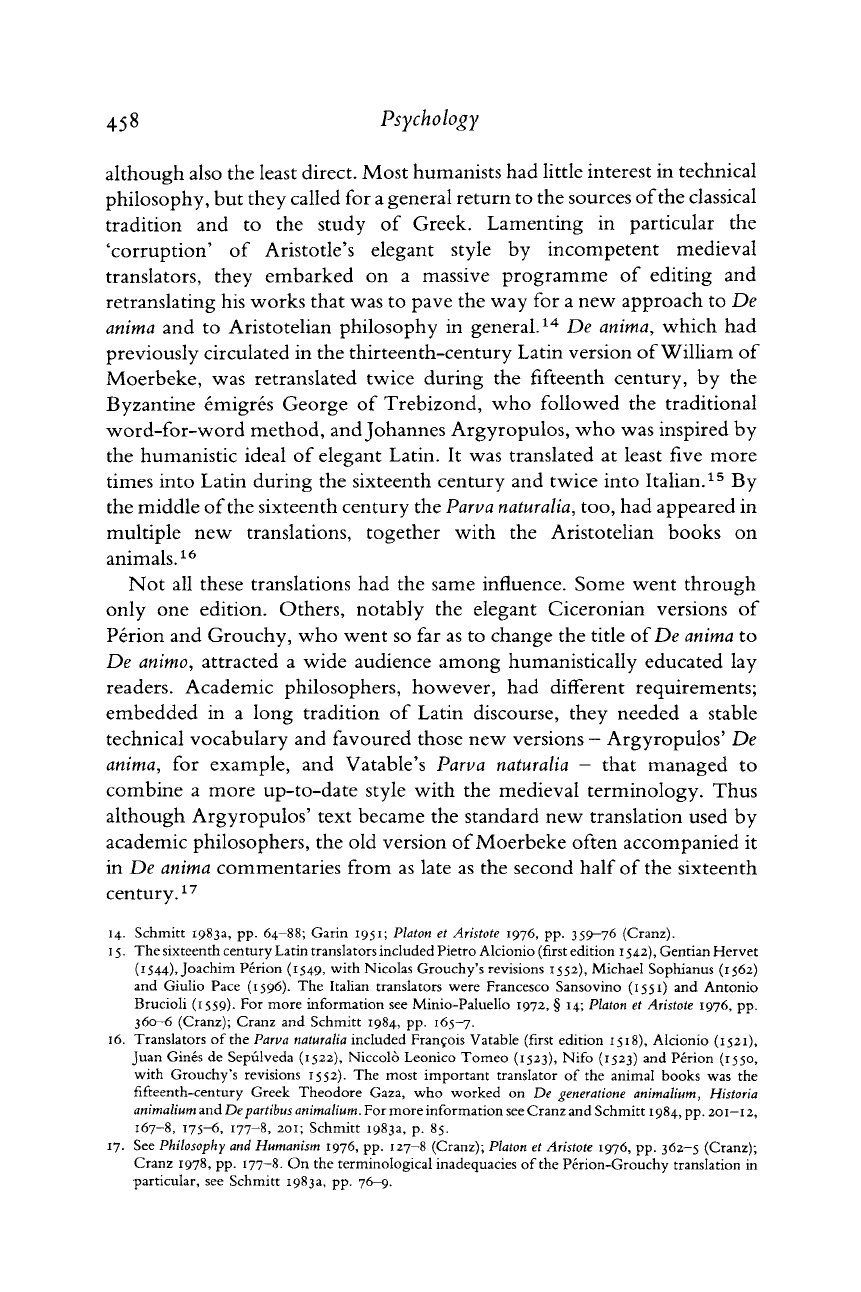
458
Psychology
although also the least direct. Most humanists had little interest in technical
philosophy, but they called for
a
general
return
to the sources
of
the classical
tradition and to the study of Greek. Lamenting in
particular
the
'corruption'
of Aristotle's elegant style by incompetent medieval
translators,
they embarked on a massive programme of
editing
and
retranslating
his works that was to pave the way for a new approach to De
anitna
and to Aristotelian philosophy in general.
14
De
anima,
which had
previously circulated in the thirteenth-century Latin version
of
William of
Moerbeke, was retranslated twice during the fifteenth century, by the
Byzantine emigres George of Trebizond, who
followed
the traditional
word-for-word method, and
Johannes
Argyropulos, who was inspired by
the humanistic ideal of elegant
Latin.
It was translated at least
five
more
times into Latin during the sixteenth century and twice into Italian.
15
By
the middle
of
the sixteenth century the
Parva
naturalia,
too, had appeared in
multiple new translations, together
with
the Aristotelian books on
animals.
16
Not all these translations had the same influence. Some went through
only one edition. Others, notably the elegant Ciceronian versions of
Perion and Grouchy, who went so far as to change the title of De
anitna
to
De
animo,
attracted
a
wide
audience among humanistically educated lay
readers.
Academic philosophers, however, had different requirements;
embedded in a
long
tradition of Latin discourse, they needed a stable
technical vocabulary and favoured those new versions
—
Argyropulos' De
anima,
for example, and Vatable's
Parva
naturalia
— that managed to
combine a more up-to-date style
with
the medieval terminology. Thus
although Argyropulos' text became the standard new translation used by
academic
philosophers, the old version of Moerbeke often accompanied it
in De
anima
commentaries from as late as the second half of the sixteenth
century.
17
14.
Schmitt
1983a,
pp.
64-88;
Garin 1951; Platon et Aristote 1976, pp.
359-76
(Cranz).
15.
The
sixteenth
century
Latin
translators
included
Pietro
Alcionio
(first
edition
154.2),
Gentian
Hervet
(1544),
Joachim
Perion
(i549>
with
Nicolas
Grouchy's
revisions
1552),
Michael
Sophianus
(1562)
and
Giulio
Pace
(1596).
The
Italian
translators
were
Francesco
Sansovino
(1551) and
Antonio
Brucioli
(1559).
For
more
information
see
Minio-Paluello
1972, § 14; Platon et Aristote 1976, pp.
360-6
(Cranz); Cranz and
Schmitt
1984, pp. 165-7.
16.
Translators
of the Parva naturalia
included
Francois
Vatable
(first
edition
1518),
Alcionio
(1521),
Juan
Gines
de
Sepulveda
(1522),
Niccolo
Leonico
Tomeo
(1523),
Nifo
(1523)
and
Perion
(1550,
with
Grouchy's
revisions
1552). The
most
important
translator
of the
animal
books
was the
fifteenth-century
Greek
Theodore
Gaza, who
worked
on De generatione animalium, Historia
animalium and Departibus animalium. For
more
information
see Cranz and
Schmitt
1984, pp. 201-12,
167-8, 175-6, 177-8, 201;
Schmitt
1983a,
p. 85.
17.
See Philosophy and Humanism 1976, pp. 127-8 (Cranz); Platon et Aristote 1976, pp.
362-5
(Cranz);
Cranz 1978, pp. 177-8. On the
terminological
inadequacies
of the
Perion-Grouchy
translation
in
particular,
see
Schmitt
1983a,
pp.
76—9.
Cambridge Histories Online © Cambridge University Press, 2008

The
concept
of
psychology
459
Academic
psychology was also influenced by the new availability of the
Greek
text of Aristotle, first published in the Aldine edition of Aristotle's
Opera
omnia
(1495-8).
The psychological works were reprinted as
part
of
the
Opera
eight times over the course of the sixteenth century,
18
also
appearing frequently in separate editions, with or without Latin transla-
tions. During this same period,
a
number
of
universities established chairs to
teach
Aristotle in the original. In this way, we see the gradual emergence
during the Renaissance
of
the historical Aristotle, who called for philologi-
cal
and historical study as
well
as philosophical analysis. This new approach
to
Aristotle bore fruit in the writing on De
anima
by Francesco Vimercato
and,
above all, Giulio
Pace.
19
Even
more important for Renaissance psychology was the humanist
rediscovery,
translation and publication of the Greek commentaries on
Aristotle's psychological works. Averroes had cited them often, and
Thomas
Aquinas had access to some in
rare
medieval translations, but at the
beginning of the fifteenth century they were generally known only by
name
or indirectly.
20
The first to appear in print, in Ermolao
Barbaro's
Latin
translation, was the
paraphrase
of
De
anima
by Themistius.
21
Fourteen
years
later, in
1495,
Barbaro's
compatriot Girolamo Donato published his
own translation of Alexander of Aphrodisias' De
anima.
22
The two other
major
commentaries on De
anima,
that by Simplicius and that attributed to
Philoponus, did not appear in Latin until the
1540s,
although they had been
used in the Greek several decades earlier by Italian writers such as Giovanni
Pico
and Agostino
Nifo.
23
To these works we should also add Alexander's
commentary
on De
sensu
and a related work, the
Metaphrasis
in
Theophrastum
De
sensibus
of Priscianus Lydus, which became
newly
and
more
widely
available during the same period. All
of
these works served as
guides to the new Greek Aristotle and represented a significant body
of
new
ideas and interpretations for writers on psychology. Themistius and
Alexander,
for example, figured prominently in the Renaissance debates on
18.
Cranz and
Schmitt
1984, p. 165.
19.
Vimercato 1543; for Pace see
Aristotle
1596a and
Schmitt
1983a,
pp. 37-41.
20. Nardi 1958, pp.
365~4
20
-
F°
r
the
medieval
translations
see
Themistius
1957 and
Philoponus
1966.
For
more
details
on the
transmission
and
reception
of the Greek
commentators
in the Middle Ages
and
Renaissance
see Cranz 1958; Catalogus translationum
i960—,
1, pp. 77—135 and 11, pp. 411—22
(Alexander of Aphrodisias); m, pp.
75-82 (Priscianus
Lydus); Mahoney 1982.
21.
Themistius
1481;
first
Greek
edition,
Themistius
1534.
22. Alexander of
Aphrodisias
1495;
another
translation
of the
second
book
appeared
in 1546. The
first
Greek
edition
is in
Themistius
1534. See Averroes 1953, pp.
393-4.
23.
Simplicius
1543,
with
a
second
translation,
Simplicius
1553;
first
Greek
edition
1527; see, in
general,
Nardi 1958, pp.
373-442.
Philoponus
1544a, 1544b;
first
Greek
edition,
Philoponus
1535. The
real
author
of the
commentary
attributed
to
Philoponus
was apparently
Stephanus
of Alexandria:
Blumenthal
1982.
Cambridge Histories Online © Cambridge University Press, 2008
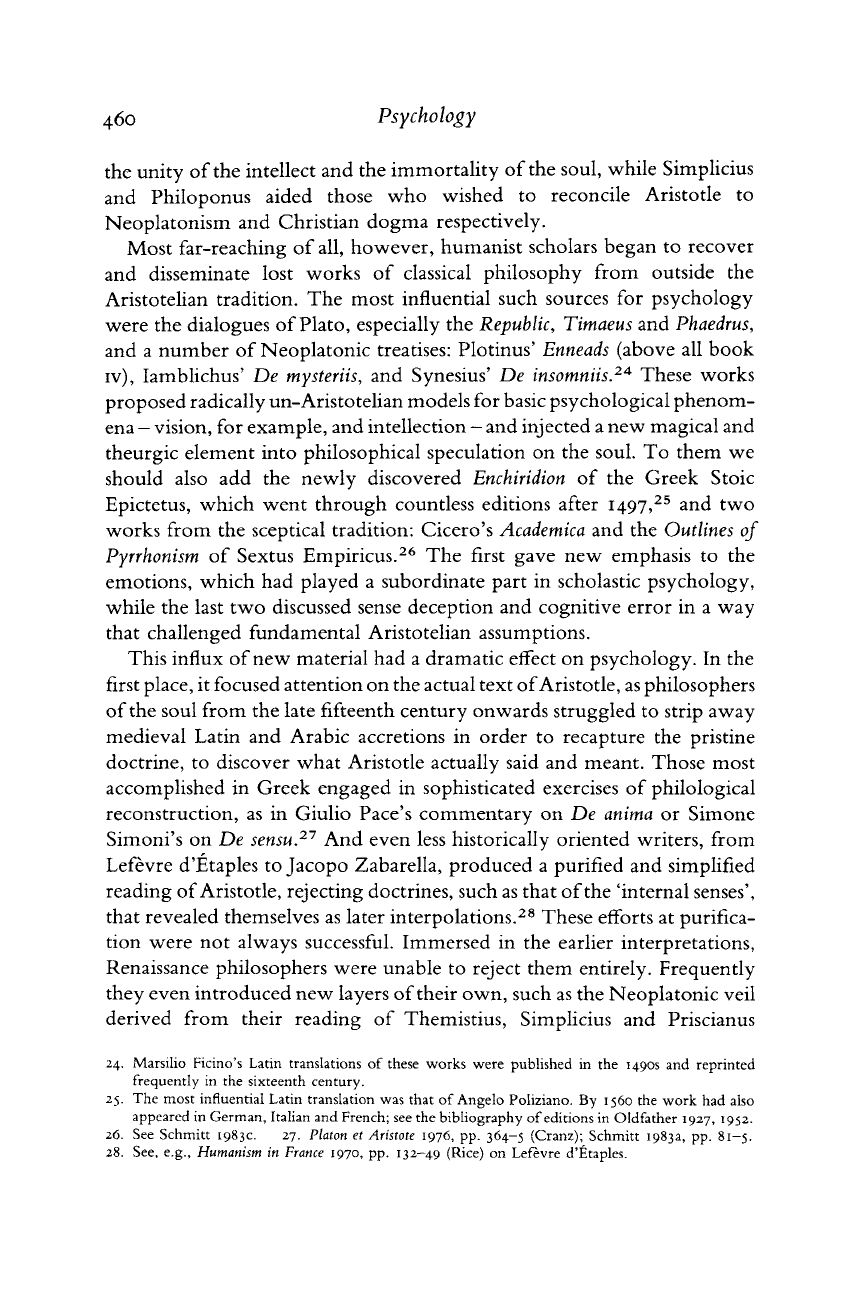
Psychology
the unity of the intellect and the immortality of the soul,
while
Simplicius
and Philoponus aided those who
wished
to reconcile Aristotle to
Neoplatonism and Christian dogma respectively.
Most far-reaching of all, however, humanist scholars began to recover
and disseminate lost works of classical philosophy from outside the
Aristotelian tradition. The most influential such sources for psychology
were the dialogues of
Plato,
especially the
Republic,
Timaeus
and
Phaedrus,
and a number of Neoplatonic treatises: Plotinus'
Enneads
(above all book
iv),
Iamblichus' De mysteriis, and Synesius' De insomniis
24
These works
proposed radically un-Aristotelian models for basic psychological phenom-
ena
—
vision, for example, and intellection
—
and injected
a
new magical and
theurgic
element into philosophical speculation on the soul. To them we
should also add the
newly
discovered
Enchiridion
of the Greek Stoic
Epictetus,
which went through countless editions after
1497,
25
and two
works from the sceptical tradition: Cicero's
Académica
and the Outlines of
Pyrrhonism
of Sextus Empiricus.
26
The first gave new emphasis to the
emotions, which had played a subordinate
part
in scholastic psychology,
while
the last two discussed sense deception and cognitive
error
in a way
that
challenged fundamental Aristotelian assumptions.
This influx of new material had a dramatic effect on psychology. In the
first place, it focused attention on the actual text
of
Aristotle,
as
philosophers
of
the soul from the late fifteenth century onwards struggled to strip away
medieval Latin and Arabic accretions in order to recapture the pristine
doctrine,
to discover what Aristotle actually said and meant. Those most
accomplished in Greek engaged in sophisticated exercises of philological
reconstruction,
as in Giulio Pace's commentary on De
anima
or Simone
Simoni's on De
sensu.
27
And even
less
historically oriented writers, from
Lefévre
d'Étaples to
Jacopo
Zabarella, produced a purified and
simplified
reading
of
Aristotle,
rejecting doctrines, such as that
of
the 'internal senses',
that
revealed themselves as later interpolations.
28
These efforts at purifica-
tion were not always successful. Immersed in the earlier interpretations,
Renaissance philosophers were unable to reject them entirely. Frequently
they even introduced new layers
of
their
own, such as the Neoplatonic
veil
derived from their reading of Themistius, Simplicius and Priscianus
24. Marsilio
Ficino's
Latin
translations
of
these
works
were
published
in the
1490s
and
reprinted
frequently
in the
sixteenth
century.
25. The
most
influential
Latin
translation
was that of Angelo
Poliziano.
By 1560 the work had
also
appeared
in German,
Italian
and French; see the bibliography of
editions
in Oldfather 1927, 1952.
26. See
Schmitt
1983c.
27. Platón et Aristote 1976, pp.
364-5
(Cranz);
Schmitt
1983a,
pp. 81-5.
28. See, e.g., Humanism in
France
1970, pp.
132-49
(Rice)
on Lefévre d'Étaples.
Cambridge Histories Online © Cambridge University Press, 2008
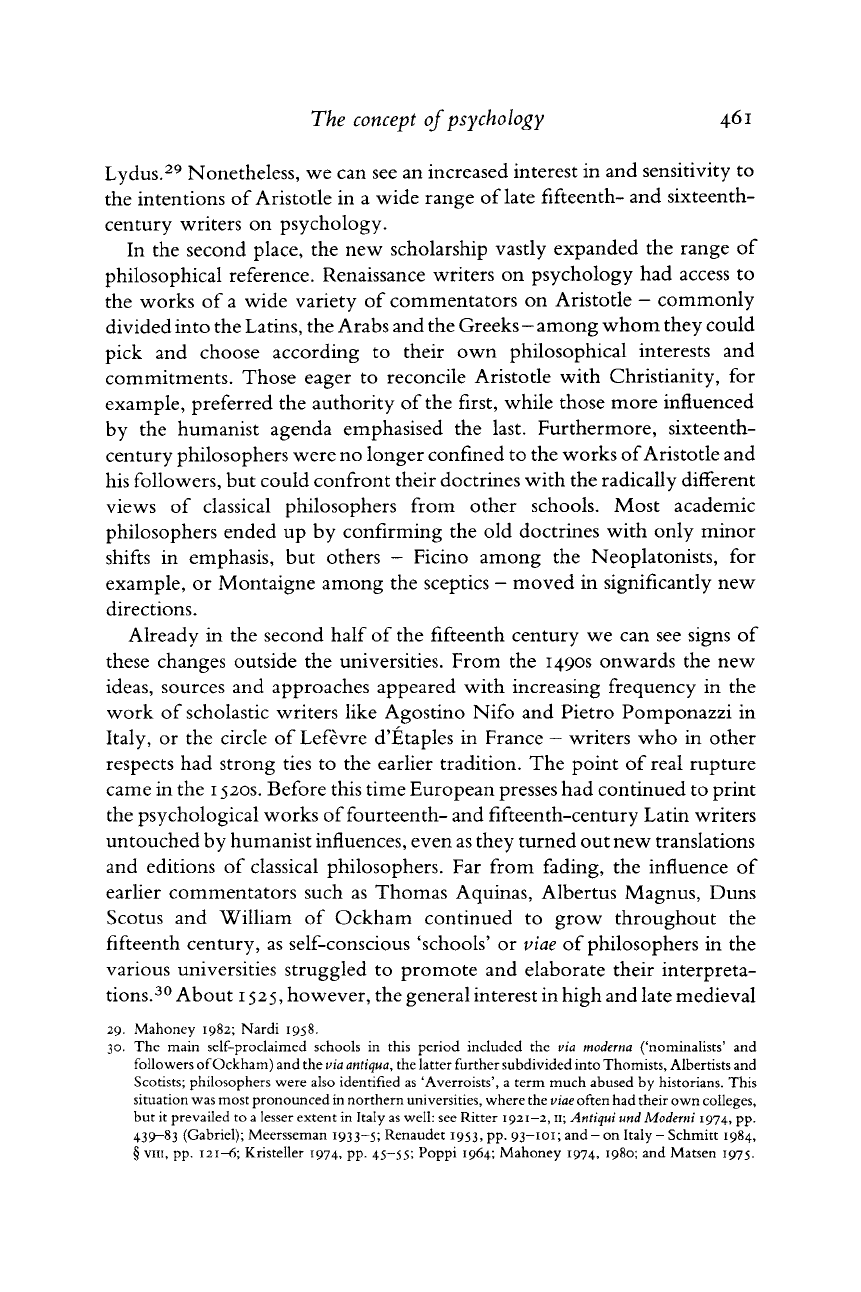
The
concept
of
psychology
Lydus.
29
Nonetheless, we can see an increased interest in and sensitivity to
the intentions of Aristotle in a
wide
range of late fifteenth- and sixteenth-
century
writers on psychology.
In the second place, the new scholarship vastly expanded the range of
philosophical reference. Renaissance writers on psychology had access to
the works of a
wide
variety of commentators on Aristotle - commonly
divided into the
Latins,
the
Arabs
and the
Greeks
- among whom they could
pick and choose according to their own philosophical interests and
commitments. Those eager to reconcile Aristotle with Christianity, for
example, preferred the authority of the first,
while
those more influenced
by the humanist agenda emphasised the last.
Furthermore,
sixteenth-
century
philosophers were no longer confined to the works
of
Aristotle and
his followers, but could confront their doctrines with the radically different
views
of classical philosophers from other schools. Most academic
philosophers ended up by confirming the old doctrines with only minor
shifts in emphasis, but others — Ficino among the Neoplatonists, for
example, or Montaigne among the sceptics - moved in significantly new
directions.
Already
in the second half of the fifteenth century we can see
signs
of
these changes outside the universities.
From
the
1490s
onwards the new
ideas, sources and approaches appeared with increasing frequency in the
work
of scholastic writers
like
Agostino
Nifo
and Pietro Pomponazzi in
Italy,
or the circle of Lefevre d'Etaples in
France
—
writers who in other
respects
had strong ties to the earlier tradition. The point of real rupture
came
in the
1520s.
Before this time
European
presses had continued to print
the psychological works
of
fourteenth- and fifteenth-century Latin writers
untouched by humanist influences, even
as
they turned out new translations
and editions of classical philosophers. Far from fading, the influence of
earlier
commentators such as Thomas Aquinas, Albertus Magnus, Duns
Scotus and William of Ockham continued to grow throughout the
fifteenth century, as self-conscious 'schools' or
viae
of philosophers in the
various universities struggled to promote and elaborate their interpreta-
tions.
30
About
1525,
however, the general interest in high and late medieval
29. Mahoney 1982; Nardi 1958.
30. The
main
self-proclaimed
schools
in
this
period
included
the via moderna
('nominalists'
and
followers
of Ockham) and the via antiqua, the
latter
further
subdivided
into
Thomists, Albertists and
Scotists;
philosophers
were
also
identified
as 'Averroists', a
term
much
abused
by
historians.
This
situation
was
most
pronounced
in
northern
universities,
where
the viae
often
had
their
own
colleges,
but it
prevailed
to a
lesser
extent
in Italy as
well:
see Ritter
1921-2,11;
Antiqui und Moderni 1974, pp.
439-83
(Gabriel);
Meersseman
1933-5;
Renaudet
1953, pp. 93-101; and - on Italy -
Schmitt
1984,
§
vni, pp. 121-6;
Kristeller
1974, pp. 45-55; Poppi 1964; Mahoney 1974, 1980; and Matsen 1975.
Cambridge Histories Online © Cambridge University Press, 2008
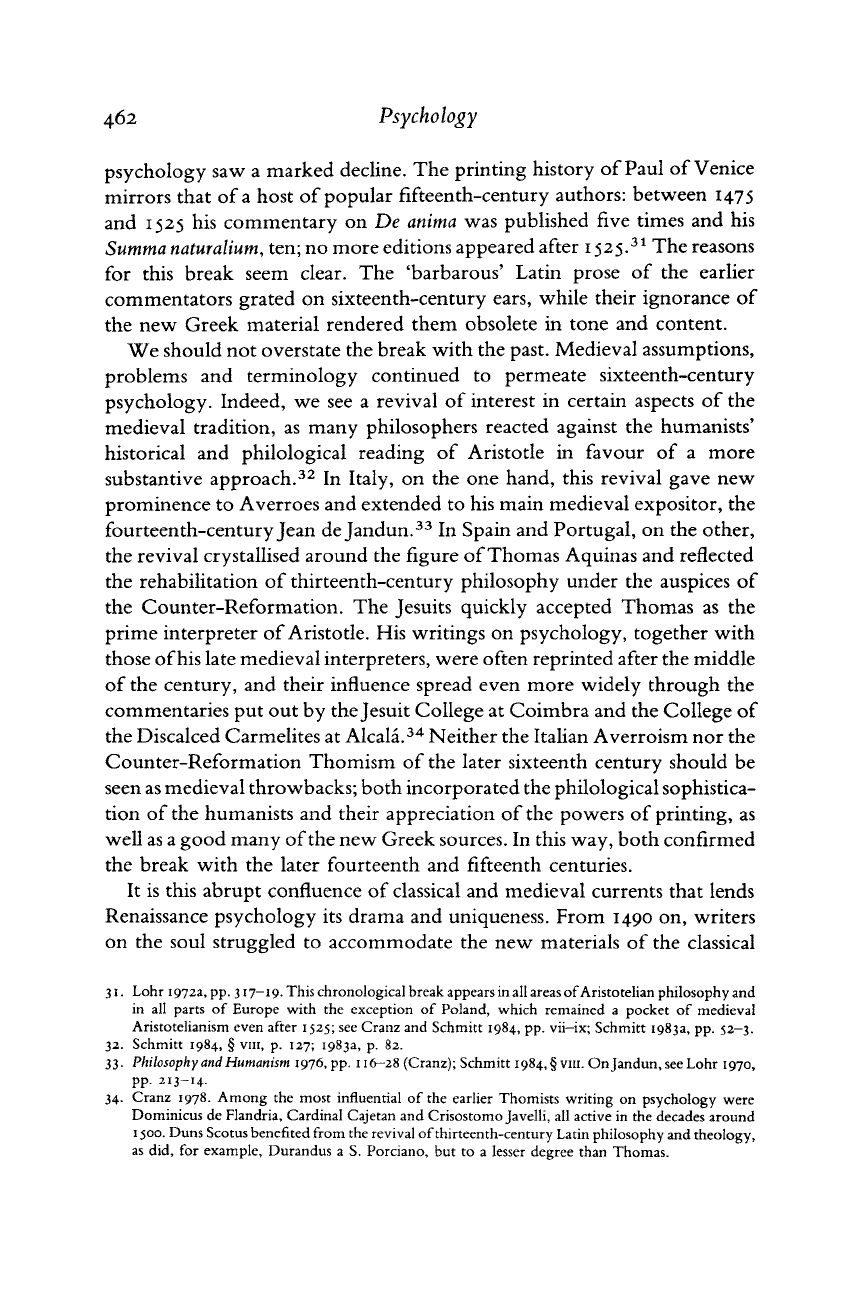
462
Psychology
psychology saw a marked decline. The printing history of Paul of Venice
mirrors
that of
a
host of popular fifteenth-century authors:
between
1475
and 1525 his commentary on De
anima
was
published
five
times and his
Summa naturalium, ten; no more
editions
appeared after
1525.
31
The reasons
for this break
seem
clear. The 'barbarous' Latin prose of the earlier
commentators grated on sixteenth-century
ears,
while
their ignorance of
the new Greek material rendered them
obsolete
in tone and content.
We
should
not overstate the break
with
the past. Medieval assumptions,
problems and terminology continued to permeate sixteenth-century
psychology. Indeed, we see a revival of interest in certain aspects of the
medieval tradition, as many philosophers reacted against the humanists'
historical and
philological
reading of Aristotle in favour of a more
substantive approach.
32
In Italy, on the one hand, this revival gave new
prominence to Averroes and extended to his main medieval expositor, the
fourteenth-century
Jean
de Jandun.
33
In Spain and Portugal, on the other,
the revival crystallised around the figure
of
Thomas Aquinas and reflected
the rehabilitation of thirteenth-century
philosophy
under the auspices of
the Counter-Reformation. The Jesuits quickly accepted Thomas as the
prime interpreter of Aristotle. His writings on psychology, together
with
those
of
his late medieval interpreters, were
often
reprinted after the
middle
of
the century, and their
influence
spread
even
more
widely
through the
commentaries put out by the Jesuit College at Coimbra and the College of
the Discalced Carmelites at Alcalá.
34
Neither the Italian Averroism nor the
Counter-Reformation Thomism of the later sixteenth century
should
be
seen
as medieval throwbacks; both incorporated the
philological
sophistica-
tion
of the humanists and their appreciation of the powers of printing, as
well
as a
good
many
of
the new Greek sources. In this way, both confirmed
the break
with
the later fourteenth and
fifteenth
centuries.
It
is this abrupt confluence of classical and medieval currents that
lends
Renaissance psychology its drama and
uniqueness.
From
1490 on, writers
on the
soul
struggled to accommodate the new materials of the classical
31.
Lohr 1972a, pp. 317-19- This
chronological
break
appears
in all
areas
of
Aristotelian
philosophy
and
in all
parts
of
Europe
with
the
exception
of
Poland,
which
remained
a
pocket
of
medieval
Aristotelianism
even
after
1525; see Cranz and
Schmitt
1984, pp.
vii-ix;
Schmitt
1983a,
pp. 52-3.
32.
Schmitt
1984, §
viii,
p. 127;
1983a,
p. 82.
33. Philosophy and Humanism 1976, pp. 116-28 (Cranz);
Schmitt
1984, § vm. On
Jandun,
see Lohr 1970,
pp. 213-14.
34. Cranz 1978.
Among
the
most
influential
of the
earlier
Thomists
writing
on
psychology
were
Dominicus
de
Flandria,
Cardinal Cajetan and
Crisostomo
Javelli,
all
active
in the
decades
around
1500.
Duns
Scotus
benefited
from
the
revival
of
thirteenth-century
Latin
philosophy
and
theology,
as did, for
example,
Durandus
a S.
Porciano,
but to a
lesser
degree
than
Thomas.
Cambridge Histories Online © Cambridge University Press, 2008
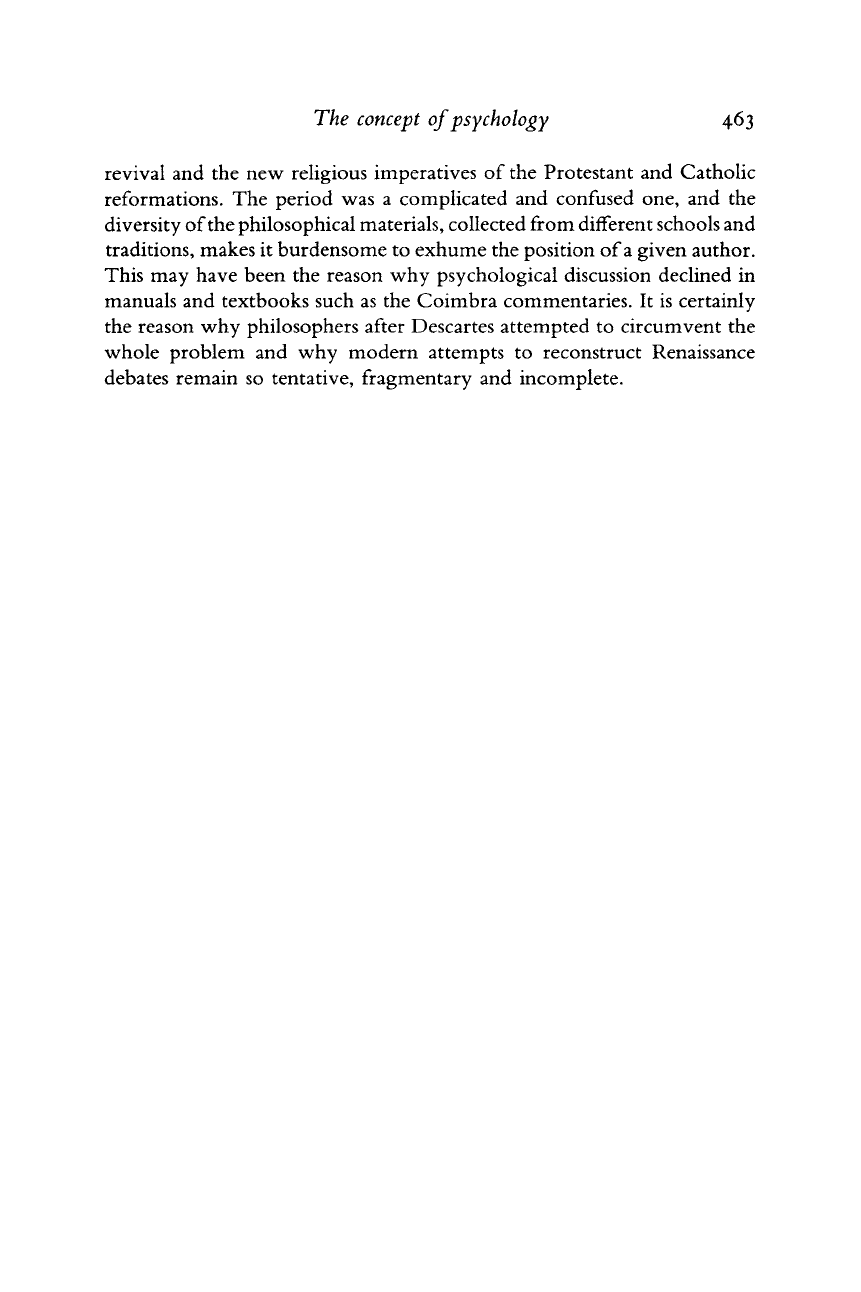
The concept
of
psychology
revival and the new religious imperatives of the Protestant and Catholic
reformations.
The period was a complicated and confused one, and the
diversity
of
the philosophical materials, collected from different schools and
traditions,
makes it burdensome to exhume the position
of a
given
author.
This may have been the reason why psychological discussion declined in
manuals and textbooks such as the Coimbra commentaries. It is certainly
the reason why philosophers after Descartes attempted to circumvent the
whole
problem and why modern attempts to reconstruct Renaissance
debates remain so tentative, fragmentary and incomplete.
Cambridge Histories Online © Cambridge University Press, 2008
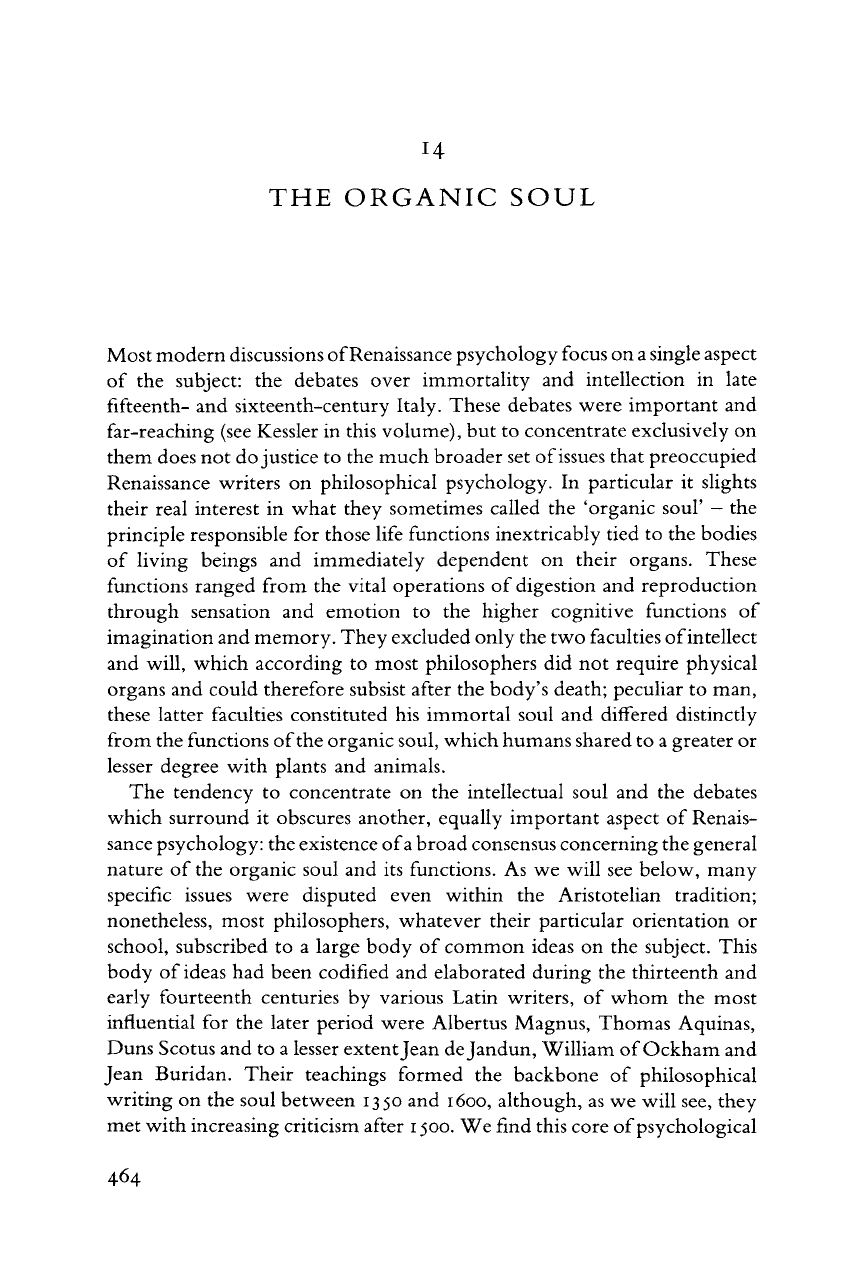
THE
ORGANIC SOUL
Most modern discussions
of
Renaissance psychology focus on
a
single
aspect
of
the subject: the debates over immortality and intellection in late
fifteenth- and sixteenth-century Italy. These debates were important and
far-reaching
(see Kessler in this volume), but to concentrate exclusively on
them does not do justice to the much broader set
of
issues
that preoccupied
Renaissance writers on philosophical psychology. In
particular
it slights
their
real
interest in what they sometimes called the 'organic soul' - the
principle responsible for those
life
functions inextricably tied to the bodies
of
living
beings and immediately dependent on their organs. These
functions ranged from the vital operations of digestion and reproduction
through sensation and emotion to the higher cognitive functions of
imagination and memory. They excluded only the two faculties
of
intellect
and
will,
which according to most philosophers did not require physical
organs
and could therefore subsist after the body's death; peculiar to man,
these
latter
faculties constituted his immortal soul and differed distinctly
from
the functions
of
the organic soul, which humans shared to a
greater
or
lesser degree with plants and animals.
The
tendency to concentrate on the intellectual soul and the debates
which surround it obscures another, equally important aspect of Renais-
sance
psychology: the existence
of
a
broad consensus concerning the general
nature
of the organic soul and its functions. As we
will
see below, many
specific
issues
were disputed even within the Aristotelian tradition;
nonetheless, most philosophers, whatever their
particular
orientation or
school, subscribed to a large body of common ideas on the subject. This
body of ideas had been codified and elaborated during the thirteenth and
early
fourteenth centuries by various Latin writers, of whom the most
influential for the later period were Albertus Magnus, Thomas Aquinas,
Duns Scotus and to a lesser extent
Jean
de
Jandun,
William
of
Ockham
and
Jean
Buridan. Their teachings formed the backbone of philosophical
writing on the soul between
1350
and 1600, although, as we
will
see, they
met with increasing criticism after
1500.
We
find
this
core
of
psychological
464
Cambridge Histories Online © Cambridge University Press, 2008
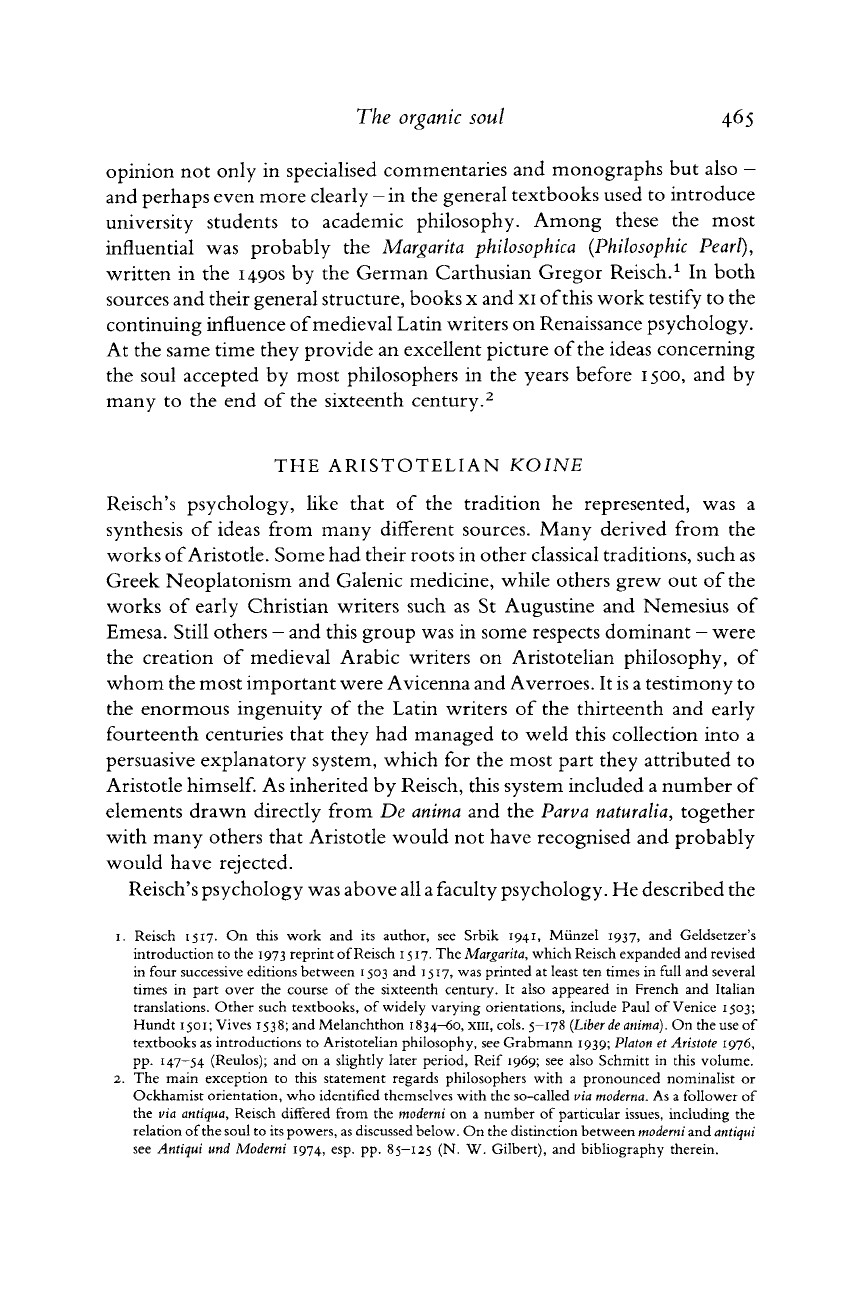
The
organic
soul
465
opinion not only in specialised commentaries and monographs but also -
and perhaps even more clearly
—
in the general textbooks used to introduce
university students to academic philosophy. Among these the most
influential was probably the
Margarita
philosophica
(Philosophic
Pearl),
written in the
1490s
by the German Carthusian Gregor Reisch.
1
In both
sources and their general
structure,
books x and xi
of
this work testify to the
continuing influence
of
medieval Latin writers on Renaissance psychology.
At
the same time they provide an excellent picture of the ideas concerning
the soul accepted by most philosophers in the years before 1500, and by
many to the end of the sixteenth century.
2
THE
ARISTOTELIAN KOINE
Reisch's psychology,
like
that of the tradition he represented, was a
synthesis of ideas from many different sources. Many derived from the
works
of
Aristotle.
Some had their roots in other classical traditions, such as
Greek
Neoplatonism and Galenic medicine,
while
others grew out of the
works of early Christian writers such as St Augustine and Nemesius of
Emesa.
Still others
—
and this group was in some respects dominant
—
were
the creation of medieval Arabic writers on Aristotelian philosophy, of
whom the most important were Avicenna and Averroes. It is
a
testimony to
the enormous ingenuity of the Latin writers of the thirteenth and early
fourteenth centuries that they had managed to
weld
this collection into a
persuasive explanatory system, which for the most
part
they attributed to
Aristotle himself. As inherited by Reisch, this system included a number of
elements drawn directly from De
anima
and the
Parva
naturalia,
together
with many others that Aristotle
would
not have recognised and probably
would
have rejected.
Reisch's psychology was above all
a
faculty psychology. He described the
1.
Reisch
1517. On
this
work and its
author,
see Srbik 1941, Miinzel 1937, and
Geldsetzer's
introduction
to the 1973
reprint
of
Reisch
1517. The Margarita,
which Reisch
expanded
and
revised
in
four
successive
editions
between
1503 and 1517, was
printed
at
least
ten
times
in
full
and
several
times
in part
over
the
course
of the
sixteenth
century.
It
also
appeared
in French and
Italian
translations.
Other
such
textbooks,
of
widely
varying
orientations,
include
Paul of
Venice
1503;
Hundt 1501; Vives 1538; and
Melanchthon
1834-60,
xm,
cols.
5-178 (Liber de anima). On the use of
textbooks
as
introductions
to
Aristotelian
philosophy,
see Grabmann 1939; Platon et Aristote 1976,
pp. 147-54
(Reulos);
and on a
slightly later
period,
Reif 1969; see
also
Schmitt
in
this
volume.
2. The
main
exception
to
this
statement
regards
philosophers
with
a
pronounced
nominalist
or
Ockhamist
orientation,
who
identified
themselves
with
the
so-called
via moderna. As a
follower
of
the via antiqua,
Reisch
differed
from
the moderni on a
number
of particular
issues,
including
the
relation
of the
soul
to its
powers,
as
discussed
below.
On the
distinction
between
moderni and antiqui
see Antiqui und Moderni 1974, esp. pp. 85-125 (N. W. Gilbert), and bibliography
therein.
Cambridge Histories Online © Cambridge University Press, 2008
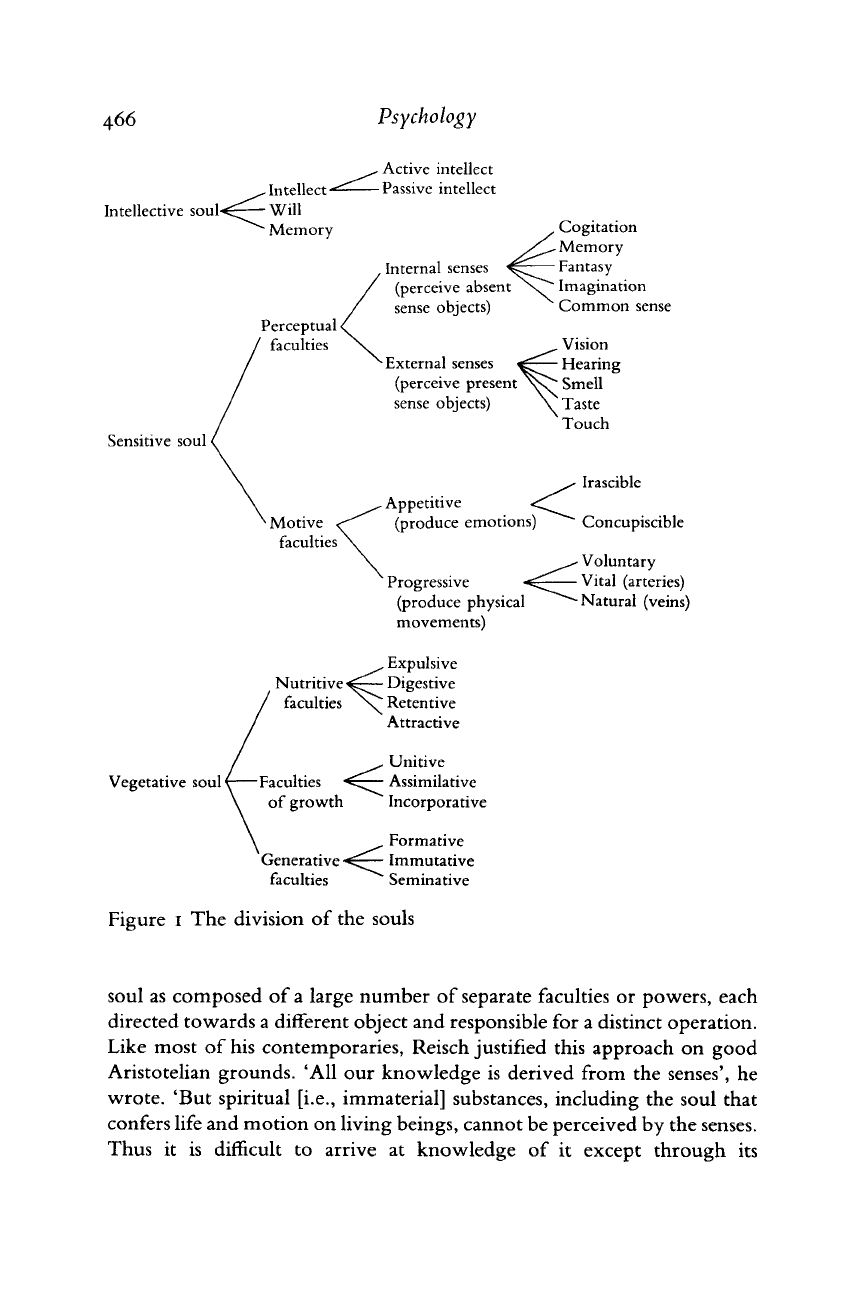
466
Psychology
Intellective soul <—Will
<
Intellect-
Memory
Sensitive soul
Perceptual
<
faculties
Motive
faculties
Vegetative souH
Nutritivem
faculties
-Faculties
of
growth
.
Active intellect
-Passive intellect
,
Internal senses
(perceive
absent
sense objects)
v
External
senses
(perceive
present
sense objects)
Cogitation
Memory
Fantasy
Imagination
Common sense
.
Vision
•
Hearing
'
Smell
*
Taste
Touch
Irascible
*
Appetitive
(produce
emotions) Concupiscible
^
Progressive
(produce
physical
movements)
,
Expulsive
•
Digestive
*
Retentive
Attractive
Unitive
Assimilative
Incorporative
Voluntary
Vital
(arteries)
Natural
(veins)
<
Formative
Immutative
racuities
Seminative
Figure
i The division of the souls
soul as composed of
a
large number of
separate
faculties or powers, each
directed
towards a different object and responsible for a distinct operation.
Like
most of his contemporaries, Reisch justified this approach on good
Aristotelian grounds. 'AH our knowledge is derived from the senses', he
wrote.
'But spiritual [i.e., immaterial] substances, including the soul that
confers
life
and motion on
living
beings, cannot be perceived by the senses.
Thus
it is difficult to
arrive
at knowledge of it except through its
Cambridge Histories Online © Cambridge University Press, 2008
